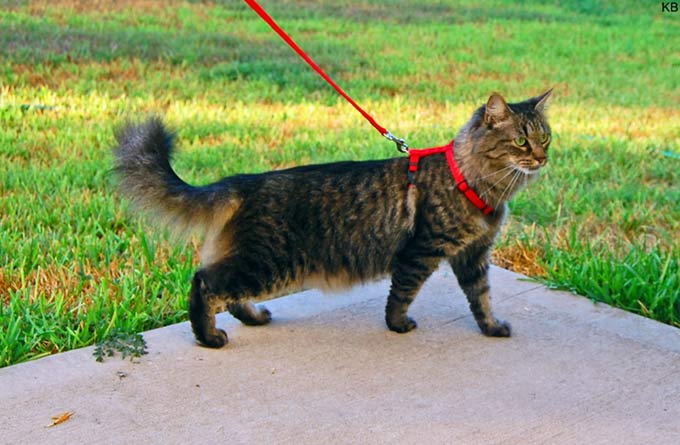How to train a cat to walk on a leash? Cats are independent pets and love to roam around free. Some cats are tempered and some are cool. It is found that some cats don’t love to walk on a leash. However, it all depends on the intention of the owner as well as the successful training we can have for the cat to walk on a leash. In this article, I am going to talk about how to train a cat to walk on a leash.
Within the happy home, your resident feline savors the exquisite ecstasy of lounging beneath a sunbeam that delicately caresses the windowsill. Yet, usher in a harness and leash to this graceful quadruped, and witness a profound transmutation – an extraordinary spectacle unfolds, and the latent inner tiger rouses from slumber. Each domesticated house cat, an embodiment of unique individuality, dances upon the stage of personality. While not every feline harbors an innate proclivity for assuming the role of an intrepid adventure cat, the realm of possibility blooms, awaiting exploration to ignite its spark.
Venturing beyond the threshold ushers your feline into a haven of emancipation, an alternate realm that stretches beyond the frontiers of home. With each delicate pawful, a symphony of novel scents, textures, and sounds serenades his senses. With meticulous care, the experience unveils itself, akin to the gentle caress of wind through the fur. Within this cocoon of security, the cat unfurls his spirit, far removed from the harbingers of racing vehicles, insidious toxins, and lurking predators.
Elevation to mastery in the art of leash-walking extends a bouquet of rewards to both guardian and feline, an offering eloquently elucidated by Sherry Woodard, a revered authority in animal behavior at Best Friends Animal Society. This endeavor encompasses more than mere exploration – it evolves into a pilgrimage to enrich the tapestry of your cat’s existence, a voyage that forges an indelible connection between you and your cherished companion. This communion bequeaths the twin gifts of augmented physical activity and spiritual intimacy, crafting a splendid tapestry of shared experience. Moreover, the training of a fostered feline in the art of leash navigation renders her a more appealing prospect in the eyes of potential adopters.
- Cat Scratching Posts for Indoor Cats
- Cat Water Fountain on Amazon
- Cat Carrier on Amazon
- Cat Automatic Feeders on Amazon
- Buy Cat Accessories on Amazon
- The Complete Guide to Adopting a Cat: Preparing for, Selecting, Raising, Training, and Loving Your New Adopted Cat or Kitten
How to train a cat to walk on a leash
In the vast expanse of opinions, anecdotes, and empirical narratives, the notion of leash-walking emerges as a tapestry threaded with potential, weaving a harmonious connection between felines and human companions. The leash takes on the role of a gentle shepherd, guiding the feline’s steps, offering a cocoon of security amid the world’s vast expanse. A tethered feline acquires a steadfast companion – unwavering in its exploration, unperturbed by distractions, and resolute on journeys spanning time and space.
Amidst the rising symphony of feline leash advocates, the pivotal query unfurls – how does one embark upon the exceptional journey of training? In this article, I am going to explain how to train a cat to walk on a leash.
1. Pursuit of the Perfect Harness
The pursuit of the quintessential harness, a task that may necessitate a touch of experimentation, ventures forth as an intricate puzzle. With the market saturated by an assortment of harness options, the process of selection acquires a veneer of complexity. Woodard imparts wisdom, “Amidst this profusion of choices, finding the harmonic resonance between the harness and your feline’s form can indeed pose a conundrum.” The paramount consideration lies in the harness’s ability to drape around your feline’s contours with an embrace that endures, an alliance of security and snugness forged. This pursuit might necessitate the sampling of various iterations, each one holding the potential to herald success.
Assume the mantle of precision by measuring your cat’s dimensions, capturing the circumference of the chest and midriff, nestled just behind the forelimbs. This meticulous calibration of size ensures a harmonious match between the feline and harness. A note of caution is sounded against the sole reliance upon a leash and collar, an arrangement that dances perilously upon the precipice of risk for the feline’s vulnerable neck and windpipe.

- Amazon Best Sellers: Best Pet Cats
- Amazon Best Sellers: Best Cat Care
- Amazon Best Sellers: Best Cat Care & Health
- The Cat Selector: How to Choose the Right Cat for You
2. Collar or harness
Stepping onto the threshold of cat leash training, the very first footprint is the choice of gear – a collar or a harness. The canine dominion reveres the collar, yet the feline terrain is distinct. A cat’s anatomy is a delicate composition, rendering collars less than harmonious. The intricate contours of the neck can render discomfort and slippage, posing a quandary.
The compass guiding through this labyrinth often points to the harness. Engineered to cradle the feline frame, bespoke cat harnesses extend a snug embrace. Precision in the balance between snugness and space is paramount, as both extremes hinder progress. Introducing the harness stages a ballet of familiarization, assuring the cat that this new companion is a source of comfort. Introducing scents, tactile sensations, and visual cues eases the introduction, carving a gentle path of acclimatization.
3. Introduce the harness
The gateway to the feline’s comfort and trust is a harness introduction draped in patience and strategy. Every stride is a stroke of connection. The harness’s weight should be a feather’s touch, it’s the material promise of flexibility. The presence of a D-ring punctuates the harmony of the ensemble, nurturing a walk that is both smooth and secure.
As the harness graces the feline’s form for the inaugural time, gradual steps are a symphony of triumph. Celebratory notes – the harness fitting snuggly or melding onto the cat – resonate in the form of rewards and affirmations. The cat’s response is an oracle, gauging its readiness for this new chapter. Guardian and companion share a duet, tempering unease with comfort, nurturing a bond woven through understanding.
- Toilet Training Kit for Your Cute Cat On Amazon
- Cat Health Supplies on Amazon
- Cat Food Supplies on Amazon
- Cat behavior Products on Amazon
- Automatic litter box self-cleaning
In this symphony of feline leash training, every measure is crafted with mindfulness, introductions painted in gentleness, and growth nurtured in understanding. The narrative we compose stitches together the elusive art of leash-walking, rendering it not just a venture, but a melody of unity and enrichment.
4. Give it enough time
One must not underestimate the intriguing initial reactions that unfold when a cat embarks on the journey of leash training. A feline may unveil an air of uncertainty, perhaps threading a touch of peculiarity into its steps. At this juncture, patience unfurls its wings as a guiding force. The novelty of the situation, akin to uncharted landscapes, beckons for a gentle understanding. The feline’s heart flutters in a realm it has yet to traverse. Encouragement and rewards are the sparks that kindle its curiosity and fortitude.
Grant the feline the grace of acclimatization as the harness snugly envelops its form. The abode transforms into a haven of exploration, where the feline cultivates a connection with its newfound accessory. Begin cautiously, minutes serving as the boundary for early ventures, especially if apprehension tingles in the air. But as the days unfurl, gradually lengthen the duration of harness-wearing. The symphony of snugness orchestrates harmony between feline and fabric. The finale of this chapter crowns success, leading to the next stage – the leash’s introduction.
- Amazon Best Sellers: Best Cat Breeds
- Cat Products for Indoor Cats
- Cat Toys for Indoor Cats Best Sellers
- Hepper’s Cucumber & Aloe Dry Shampoo
5. Leash your Cat
In the grand theatre of training, the leash assumes the role of a prop pivotal to the script. The leash’s stature requires calculated consideration, its length spanning 5 to 6 feet. A length too curt tangles in the dance of movement, while excessive length orchestrates tension. The voyage of leash incorporation hinges on the feline’s temperament and comfort, an interval spanning 1 to 7 days. As this overture unfolds, choose a canvas of ample space to accommodate this exploration, safeguarding furniture and fragile relics.
Although the leash’s potential length stretches beyond the three-foot mark, the initial stages necessitate a more intimate connection. As your feline’s comfort burgeons, the leash’s length can extend to the five or six-foot range, a sphere that often aligns with his proximity preferences. Amidst this pilgrimage of learning, a symphony of rewards – treats, playthings, and tender caresses – paves the path, a melodic accompaniment to the narrative of exploration.
As the leash cradles your hand, refrain from dragging. The prologue of the feline’s outdoor debut commences. Lures abound – treats, toys, tokens of adoration – beckoning the feline to acquaint itself with this novel pairing of harness and leash. Amid this orchestration, a crucial command emerges – the feline’s name, accompanied by the gentle pull of the leash. Applause comes in the form of rewards, validating each step toward mastery.
6. Pick the Ideal Location for the Outdoors
Having cultivated your feline’s confidence through indoor escapades, a pivotal crossroads beckons – the choice of the inaugural outdoor setting. The seeds of success take root within an oasis that balances security and serenity. An enclave of semi-privacy, free from the cacophony of distractions, unfolds as the optimal stage. Woodard’s counsel positions the haven of a fenced backyard as a protective cocoon, a fortress that shields you from the throes of traffic, the bark of canines, and the jarring symphony of urban existence. In this intricate strategy, the celestial compass takes its role, a meteorological forecast devoid of rain and gusts steering the course for an uninterrupted sojourn.
- Surprise Subscription Boxes for Cool Cat On Amazon
- Build Your Cat Box. 1 Box Every 3 Months
- Litter Boxes for Your Lovely Kitten On Amazon
- Cat Breed Test
- Cat leash and harness set
7. Gear Up for the Training
As the appointed day casts its glow, enrobe your feline in the harness and leash, a vestment that symbolizes newfound freedom. To assure readiness, a towel stands sentinel at your side, an instant lifeline for a swift retreat if circumstances dictate. As your feline’s paws grace uncharted turf, a symphony of sensory delights unravels – the allure of rolling upon textured grass, the temptation to ascend modest heights, and the enthralling olfactory foray into this lush, new realm.
Even amidst the crescendo of exhilaration, the rhythm of moderation prevails. Woodard advocates for the maiden outdoor jaunt to remain succinct, a prelude that hints at the myriad escapades yet to unfold.
8. Go outdoor
A crescendo echoes as the weeks of shared dedication culminate. Armed with newfound assurance, the moment has arrived to traverse the threshold into the wider world. With the verdant backyard and a neighboring garden, these realms unravel into a feline’s open-air sanctum. A pageant of transition takes center stage – from the refuge of home to the expanse of the outdoors. Victory is celebrated through tender care and rewards, a testament to the arduous voyage undertaken.
Guiding the feline toward its desired course is a choreography of signals – a gentle nudge or coaxing tug. Gradually, the feline intertwines with its newfound domain, a sensory symphony weaving sounds, scents, and hues. The span of acclimatization, akin to the rich tapestry of feline nature, extends from a single week to a generous four. For astute learners, swift mastery may even grace the landscape.

9. Be cautious
Whispers of caution beckon, a necessary companion to the feline’s guardian. The exterior realm unfurls a canvas of trials and trepidation. The uncharted territory introduces fledgling travelers to unexpected ordeals – dust, contagion, barking sentinels, parasites, and the fleet passage of vehicles. The cat’s sanctuary, nurtured within the home, should be preserved with a gentle touch. Coercion is a dissonant note. The feline’s sanctity deserves reverence. In this mastery, the feline emerges as an endearing companion, a fellow sojourner on shared odysseys. Yet, an essence of liberty must remain, for the feline’s spirit thrives in its realm of freedom.
10. Navigating Setbacks with Grace
The duet of leash walking, a harmonious partnership between guardian and feline, echoes with the strains of shared joy. Yet, should your feline unveil signs of unease, the tempo must adjust. Patience takes the stage as the guiding maestro, slowing the cadence to align with your feline’s rhythm. A dance of variability unfolds within the realms of species, some demanding a longer symphony to embrace the novelty’s melody.
- Cat Guide Book on Amazon
- Cat Breed Book on Amazon
- Cat Behavior Book on Amazon
- Cat Training Book on Amazon
- Amazon Best Sellers: Best Cat Training
- Cat Grooming Supplies on Amazon
Amidst the grand interaction of feline nature, the art of leash walking may not find resonance with all. Yet, within the canvas of outdoor exploration, myriad avenues unfurl. The grandeur of ground traversal might elude some, but a stroller stands as a chariot of delight, an alternate vehicle to traverse the world. For those yearning to savor the outdoors, a cat tent emerges as a haven of allure, an enclosed tapestry where your feline can revel in the embrace of verdant vistas, awash with an aura of comfort and security.
Final thought
The realm of leash training, a domain open to felines of diverse ages, unveils its corridors to all. However, the journey may unfold more seamlessly for a sprightly kitten, unburdened by the conventions of mature habits. The majority of kittens exude a tapestry of comfort and sociability, traits that manifest in an effervescent spirit of outgoing exploration.
When your feline exhibits a sense of trepidation in the face of this new odyssey, grace it with the gift of patience. The leash becomes an alchemical conduit, transforming trepidation into shared delight. “Allow time to unfold, tread with measured strides, and invoke the power of incentives,” Woodard imparts sagely. Her conviction hinges on the notion that felines harbor the capacity to astonish their stewards by discovering joy within activities they initially regarded as uninviting.



